 Alzheimer’s Disease: Symptoms, Causes and Natural Support Strategies
Alzheimer’s Disease: Symptoms, Causes and Natural Support Strategies
One of the fastest growing diseases in the industrial world is Alzheimer’s disease (AD). This is characterized by massive degeneration of the brain that causes disruptions in memory, cognition, personality that finally culminates with brain death. It is estimated that a new person is diagnosed with Alzheimer’s disease in the United States every 65 seconds.
Approximately, 6.7 million Americans have Alzheimer’s and that number is expected to go up to 15 million by the year 2050 (1). In this article, you will learn the early symptoms and the progression of Alzheimer’s as well as the root cause factors involved in this disease. I will also go over some great natural strategies you begin to apply to improve your brain health and get the most out of life.
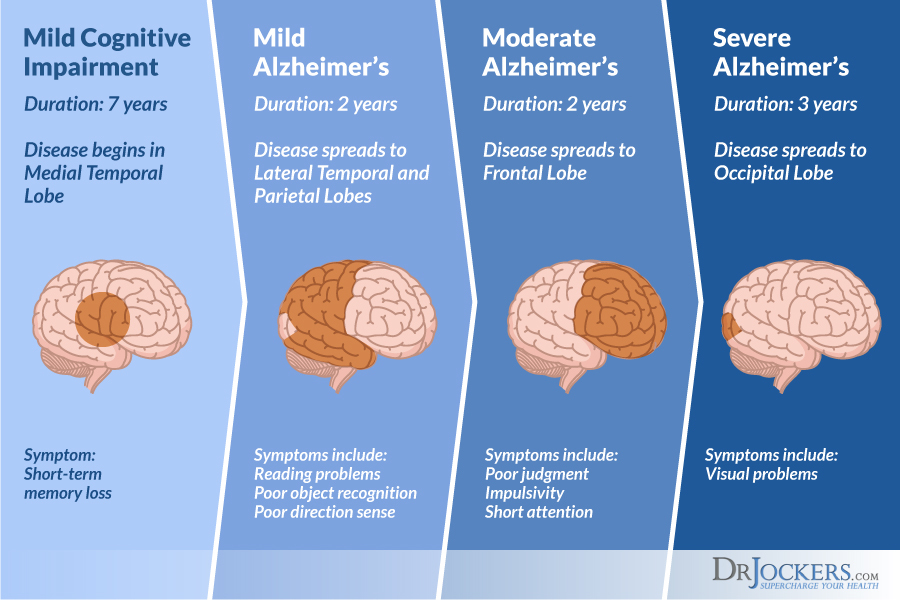
The Alzheimer’s Disease Burden:
Alzheimer’s disease cripples the individuals’ brain to the point where they cannot form new memories. They are a danger to themselves because they are entirely unable to take care of even the most basic needs. Most individuals survive for 5-10 years with AD.
These individuals need constant care-giving which creates a massive economic burden on the family. New reports show there are more than 15 million Americans providing care for someone with AD. This is a tremendous financial, physical and emotional burden to help care for a loved one with AD.
The average caregiver taking care of someone with Alzheimer’s encounters over $50,000 in out of pocket expenses each year (1, 2).
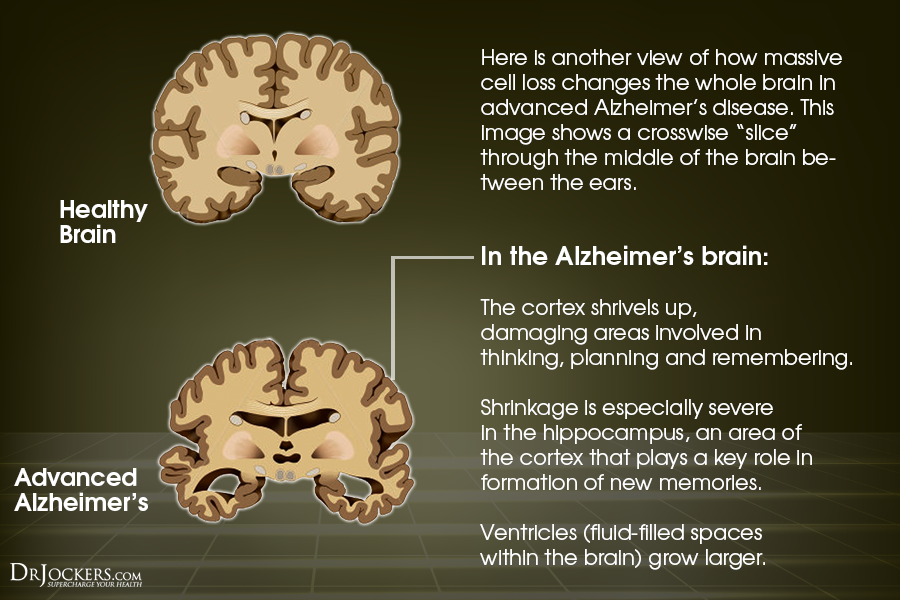

The Alzheimer’s Disease Degenerative Process:
Alzheimer’s disease and dementia are characterized by massive neuronal loss in the temporal lobe hippocampus region of the brain (3, 4). The hippocampus is the major region where we process and create short term memory. This causes problems with short term memory, behavioral changes, depression and irritability, balance problems and disorientation.
AD is also associated with damage to the Amygdala and limbic regions of the brain. These areas are responsible for our response to fear, our emotions and behavior. This is why AD patients struggle with irritability, anxiety, mood disorders and depression (5).
AD diagnosis is made by observing neuron loss of medium and large sized pyramidal cells and the presence of intraneuronal neurofibrillary tangles (NFTs) and extracellular deposits of amyloid filaments that are surrounded by altered neural processes and glia cells. These NFT’s with amyloid are called senile plaques and they are found in greater abundance in the hippocampus, amygdala and other limbic regions (6).

Poor Blood Sugar Signaling and Alzheimer’s Disease
Research has shown that Alzheimer’s disease development and progression is highly influenced by lifestyle factors. A recent study published in the Journal of Alzheimer’s Disease confirmed earlier reports that AD is characterized by chronic inflammation and insulin resistance in the brain. Researchers have titled this pathophysiological pattern type-3 diabetes (7, 8, 9).
These researchers found that as blood sugar signaling patterns are disrupted it leads to elevated blood sugar and the formation of Advanced Glycation End Products (AGE’s). The AGEs destroy cell membrane function and damage insulin receptor activity creating a vicious cycle of elevated blood sugar and inflammatory stress. AGEs cause massive destruction throughout the body and have an affinity for neurological tissue (10, 11).

Blood Brain Barrier and Alzheimer’s Disease:
The blood brain barrier (BBB) is a tight network of blood vessels that is designed to only allow small nutrients to pass into the brain. The BBB is a mechanism the body uses to protect the brain from oxidative stress, infectious microbes and chronic inflammation.
Individuals with Alzheimer’s have alterations in the BBB where they have increased permeability which therefore allows greater stress on the brain (12). This happens through 3 major mechanisms
1) Hypoglycemia: Low blood sugar causes a partial starvation of the brain tissue and the body responds by opening up the BBB to allow for more nutrients to cross. This also allows for more toxins and oxidative stress to effect brain tissue (13).
2) Hyperglycemia: High blood sugar causes more oxidative stress that damages the endothelial lining of the BBB, weakening this protective shield and making it more permeable to larger compounds. This causes increased stress on the brain tissue and leads to insulin resistance in the brain. Increased insulin levels are associated with the neurofibrillary tangles and amyloid plaque found in Alzheimer’s disease (14, 15).
3) Magnesium Deficiency: Blood sugar imbalances deplete magnesium and many B vitamin stores in the body. Magnesium plays a key role in the capillary tone of the endothelial membrane. Magnesium deficiency weakens the endothelial lining and makes it more permeable to heavy metals such as aluminum which is classically found in Alzheimer’s disease (16, 17, 18).
The MicroBiome and Alzheimer’s Disease
There has been a tremendous amount of research linking the gut microbiome and neurological health. Research has indicated that low levels of healthy lactobacillus and bifidobacterium are linked with increased brain excitability and neurological inflammation (19, 20).
These microbes help to break down the excitatory neurotransmitter glutamate into the inhibitory neurotransmitter GABA. Low levels of GABA production are associated with anxiety, seizures, depression, dementia and Alzheimer’s (21, 22).
Additionally, it has been shown that some microbes secrete amyloid as a byproduct of their metabolism. This endotoxin is linked to the pathogenesis of Alzheimer’s disease. It is thought that high levels of amyloid producing bacteria are a significant factor in the development of Alzheimer’s (23, 24).
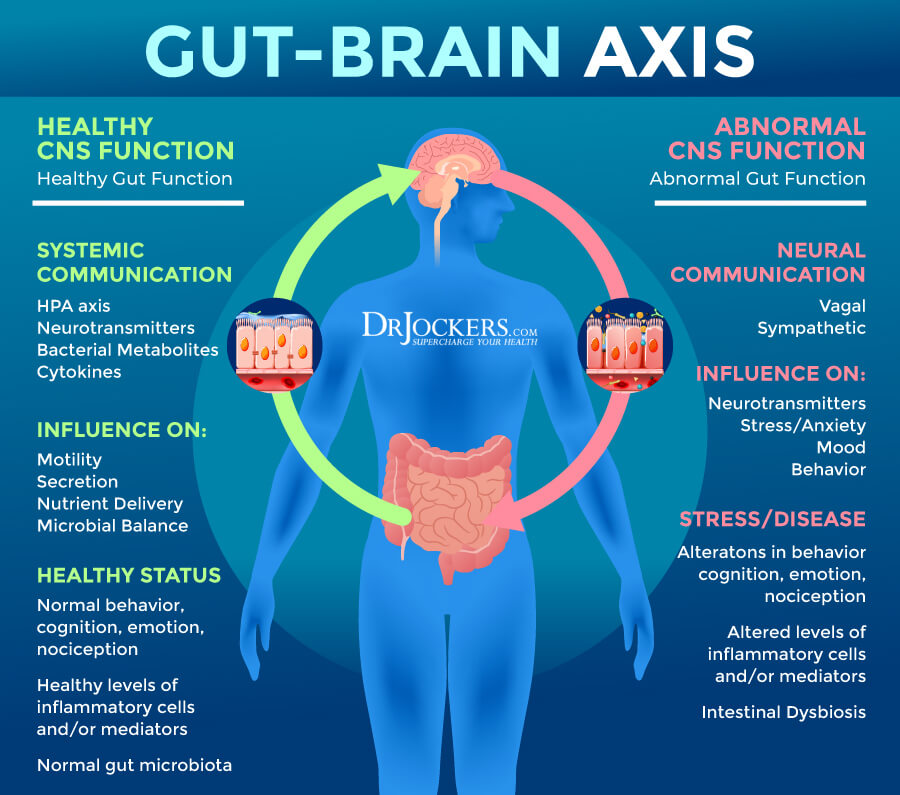
Aluminum and Alzheimer’s Disease
Aluminum is found in high amounts within the neurofibrillary tangles of Alzheimer’s disease patients. How does it get in there? Through a combination of blood sugar dysregulation, gut dysbiosis and chronic inflammation and environmental aluminum exposure.
Aluminum is used in the processing of many different industrial products. We are exposed to aluminum in vaccines, deodorants, medications, canned foods and tap water. Aluminum has an affinity for brain tissue due to 2 major mechanisms (25, 26, 27)
1) Slow Absorption and Uptake Rates: Because aluminum is absorbed by the body slowly and the uptake into the brain is progressive, many scientists believe it is a safe additive in food and drinking water treatment.
2) Aluminum’s Ionic Size: This particle is similar to iron in size and uses iron-evolved mechanisms to enter the highly active, iron-dependent cells responsible for memory processing. Aluminum accumulates in these iron-dependent cells and dysregulates the iron homeostasis which causes brain hypoxia and neuronal cell death.
AD is a human form of chronic aluminum neurotoxicity. The causality analysis demonstrates that chronic aluminum intake causes AD.
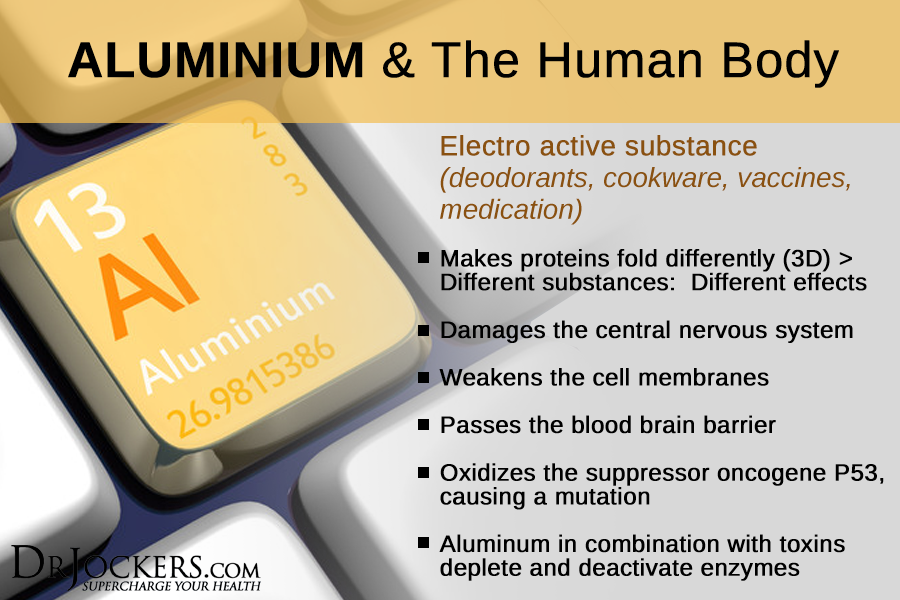
Mitochondrial Dysfunction:
Every cell of the body has mitochondria within it that produce energy for the cell. The mitochondria are the battery packs of the cell and they are extremely important. High levels of oxidative stress wear down the mitochondria and cause a dysfunctional state. Studies have found that individuals with Alzheimer’s disease have an advanced state of mitochondrial dysfunction (28, 29).
Individuals suffering from AD are evidenced to have massive cell death of the hippocampus and amygdala regions of the brain (30). Research has shown that this is initiated by a profound glutathione (GSH) decrease and a mitochondrial dysfunction.

Glutathione Depletion and Nrf2:
In AD, the cells are under so much stress that their main protective shield (GSH) gets worn down and oxidative stress damages the mitochondria and the DNA leading to cell death. Poor blood sugar control and high environmental toxin exposure are known to deplete glutathione levels and impair mitochondrial function (31).
A key pathway that maintains cellular glutathione levels and the ability of the cell to adapt to stress is called Keap1-Nrf2. When this pathway breaks down it causes increased levels of oxidative stress within the cell that leads to the glutathione depletion and mitochondrial dysfunction (32). This pathway must be addressed in order to prevent or reverse AD symptoms (33).

Anti-Inflammatory Nutrition:
An anti-inflammatory nutrition plan that is low in carbohydrate and rich in healthy fats and antioxidants is critical to preventing and treating Alzheimer’s disease. The brain is primarily water, fat and cholesterol. These are all key building blocks for promoting healthy brain function and rebuilding a damaged brain.
The proper nutrition plan to beat AD is rich in phytonutrient dense vegetables, healthy fat and clean protein sources. Healthy fat sources such as coconut, avocados, olive oil & sprouted nuts and seeds must take a central role in the diet to promote healthy brain function. I recommend a ketogenic diet for Alzheimer’s patients and you can read about why in this article.
Healthy Proteins & Antioxidants:
Healthy proteins include wild-caught fish, grass-fed red meat and organic chicken, turkey and eggs. Grass-fed beef is loaded with long-chain omega 3 fatty acids, saturated fat, cholesterol, vitamin B12, and conjugated linoleic acid which are all necessary for healthy neurological function.
Additionally, grass-fed beef contains carnosine, wild salmon contains astaxanthin and organic pasture-fed eggs have retinol, lutein & zeaxanthin. These fat-soluble antioxidants protect the brain and neurological tissue from AGEs and other damaging free radicals. Superfood herbs like turmeric, cinnamon, cloves, oregano, rosemary, thyme, ginger, basil, etc. should be used as much as possible.

Critical Nutrients for Brain Health:
Regular exercise and sun exposure are extremely critical factors to boost oxygenation, anti-aging hormones and vitamin D3 levels. Vitamin D3 supplementation of 10,000 IU daily is often needed. High quality multi-vitamins, magnesium, extra B complex vitamins, zinc & selenium as well as probiotics and purified omega 3 fatty acids should be used as well.
Individuals at risk for AD have sleep challenges throughout their lives and have reduced melatonin signaling systems in their brain. Establishing regular sleep cycles by going to bed early and getting a full 8 hours of sleep each night is essential. Adding in certain teas such as valerian root, chamomile and passionflower can be especially helpful.
Additionally, you can use lavender, chamomile and peppermint essential oils to relax the nervous system, oxygenate the body and induce deeper sleep. Healthy melatonin levels help the brain to clean up damaged cells (autophagy) including the NFT’s that are characteristic of AD.
Good sleep and optimal melatonin secretions also positively influence healthy genetic expression, circadian rhythms that improve anti-aging characteristics and human growth hormone levels which boost immunity, reduce inflammation and build lean body tissue and a healthy physique.

Stimulating NeuroGenesis:
One of the biggest breakthroughs in neuroscience over the last 20 years has been the discovery of neurogenesis. This refers to the ability of the brain to generate new healthier and stronger cells and synaptic junctions. The brain can literally re-wire itself. In the case of AD, the brain is breaking down faster than it can rebuild which is called neurodegeneration.
In order to grow stronger and healthier neuronal cells the neurons secrete a compound called Brain derived neurotrophic growth factor (BDNF). BDNF encourages the growth and differentiation of new neurons and synapses. In the brain, it is most active in the hippocampus and cortex and is vital to learning, memory and higher thinking (34).
Key ways to simulate BDNF include regular exercise, novel movement patterns such as using your non-dominant hand for activities, doing cross-crawl style movements, aromatherapy, learning new concepts, listening to classical music, social interaction and laughing. Read this article on neurobics, which are specific exercises to stimulate BDNF production.
Action Steps to Improve Brain Health
Here are the best action steps to get started with on your journey to improve your brain health. It is important to note that these strategies are not at this time FDA approved to prevent, mitigate, treat or cure Alzheimer’s disease and should not be confused as such. You should always consult with your physician before stopping or changing medications or taking on new health strategies.
Additionally, you should be working with a functional health practitioner to help guide you through these strategies. This is not an exhaustive list and there are other natural therapeutic strategies that I and functional health practitioners will utilize to help individuals with Alzheimer’s.
Anti-Inflammatory Nutrition Plan
Follow an Anti-Inflammatory nutrition plan that is full of healthy, life-giving foods and be sure to avoid exposure to aluminum cans by choosing fresh or frozen organic food as much as possible. A healthy diet and lifestyle include a lot of clean water and phytonutrient rich raw and lightly cooked vegetables.
It is also important to consider a ketogenic diet which has been shown to have neuroprotective properties and may be incredibly therapeutic for individuals dealing with neurodegenerative conditions. A study of 152 humans with Alzheimer’s saw significant improvements in brain function after ketone levels were raised during 90 days of MCT oil supplementation (35). Additionally, several animal studies have demonstrated a similar effect by implementing a ketogenic diet.
Reduce Stress:
Reducing stress is a critical for reducing inflammation and improving brain health. I recommend that you reduce stressors from your life as much as possible. Turn off the news, and only look at it once a day or a few times a week for a specific period. Reduce your social media use and time on the internet.
Avoid people and situations that bring you down. Surround yourself with loving and uplifting people. Engage in uplifting and relaxation-promoting activities. Read, try some arts and crafts, play cards or board games, sing, and dance.
Spend time in nature and do some grounding walking barefoot on grass. Practice daily gratitude and try positive affirmations. Practice self-love and laugh with friends and family. Meditate, pray, journal, and try daily breathwork. Be grateful and smile more and look for ways to laugh.

Improve Your Sleep:
Prioritizing good sleep is just as important as reducing your stress levels. Develop a regular schedule going to bed and getting up at the same time every day to support your circadian rhythms.
Avoid electronics, sugar, caffeine, heavy foods, and stress close to the bed. Engage in relaxing activities, including stretching, relaxing baths, meditation, and prayer. Make sure that you have a supporting bed, pillow, and bedding, and sleep in a dark calming room

Make Learning Your Hobby:
Continual and life long learning is one of the best ways to improve BDNF levels. Studying new subjects, reading books, learning languages, playing new instruments and doing crossword puzzles are extremely healthy for the brain.
Various brain based exercises can be performed daily to help boost Brain Derived Neurotropic Growth Factors (BDNF) that improve the health and stability of the brain.
Neurobics is a term that refers to the physiological effects of unique and non-routine ways of thinking and moving and their effects on the brain. Practicing neurobics on a regular basis can strengthen your brain and improve your mood, memory and mindset.
Routine activities become so automatic in the brain that they require less brain activity. Unique activities produce more neurotransmitters and have a greater effect on altering and strengthening neurons and synaptic connections. Check out my video on brain exercises and the image below on neurobic exercises to improve your brain health.

Reduce Toxin Exposure
Reducing your toxic exposure is critical for preventing brain degeneration. Buy organic food as much as possible. Stop using conventional beauty, body, and household products, and replace them with organic, natural, or homemade alternatives.
Use glass, stainless steel, wood, and bamboo products instead of plastic. Spend time in nature and breathe in the fresh air. Use a good indoor air filtration system. Make sure that you drink clean, toxin-free water by using a high-quality reverse osmosis system.

Support Detoxification Pathways
It is not enough to put good things into your body, you have to make sure that the bad things come out as well. Drink plenty of water to support detoxification through sweating and urine. Support your detoxification pathways to protect your body from brain inflammation.
I recommend using infrared saunas to promote detoxification through sweating. Try rebounding and dry skin brushing to support your lymphatic pathways. Support two major detoxifying organs, your kidneys and liver with herbs like milk thistle, parsley, dandelion and bioactive carbons which can penetrate and remove toxins from deep within the tissues and cells.

Include Magnesium & B Vitamin Rich Foods:
Magnesium helps to improve blood sugar signaling patterns and protects the blood-brain barrier. The best magnesium and B vitamin rich foods include dark green leafy veggies, avocados, grass-fed animal products, raw cacao and pumpkin seeds.
You can also do Epsom salt baths to support your magnesium levels. It would also be wise to supplement with a good magnesium and B complex supplement. Look for magnesium L-threonate which is the best form of magnesium for crossing the blood brain barrier.
When it comes to B vitamins, it is best to look for one with pre-activated forms such as methyl-folate, methyl-cobalamin (B12), Pyridoxal-5-Phosphate form of B6, and Riboflavin-5-phosphate form of vitamin B2. The methyl groups are in the active form and will be better utilized by the body.

Use Antioxidant Rich Herbs:
Carminatives are herbs that help to improve digestive health by reducing pathogens in the gut, stimulating the production of stomach acid, bile and pancreatic enzymes and modulating the gut microbiome.
Examples of these herbs include turmeric, ginger, oregano, garlic, basil, thyme and rosemary. These herbs help to improve digestion, reduce inflammation and support a healthy brain. There are a number of ways to use these that I discuss in the following image. I like putting the herbs on foods, using herbal teas, fermented foods and essential oils.

Supplement With Omega 3’s:
Omega 3 fatty acids and in particular the long chain variety EPA and DHA are critical for stabilizing blood sugar, improving neurogenesis and neurotransmitter production (36, 37). Consume grass-fed meat, grass-fed butter, wild-caught fish and spirulina to get it in your diet.
Plant based omega 3’s such as flax oil only contain the small chain omega 3 called ALA and do not have any DHA. It is very hard for our body to convert ALA into DHA so it is best to get a high-quality fish or krill oil that is rich in EPA and DHA. You want to find a brand that is molecularly distilled to take out any heavy metals and other unwanted contaminants.
Be sure to discuss with your physician before using as fish oils have a blood thinning affect and can be contraindicated if you are on blood thinning medications.

Ground Your Body:
In our society we are surrounded by toxic electromagnetic frequency’s (EMF’s). These EMF’s increase stress within our body and alter neurotransmitter function.
By going outside daily and walking barefoot on grass, dirt or sand you absorb natural EMF’s from the ground that balance your electrical rhythms. Follow the steps in this article here.

Improve Your Mitochondria:
The mitochondria are the energy powerhouses of every cell. When someone has a neurodegenerative disorder it is a clinical sign that they have dysfunctional activity going on in the mitochondria.
Support your mitochondria with clinical doses of CoQ10, L-carnitine, N-acetyl cysteine, creatine monohydrate, B vitamins, magnesium, alpha lipoic acid and D-ribose. You can find mitochondrial support supplements that have most if not all of these key nutrients.
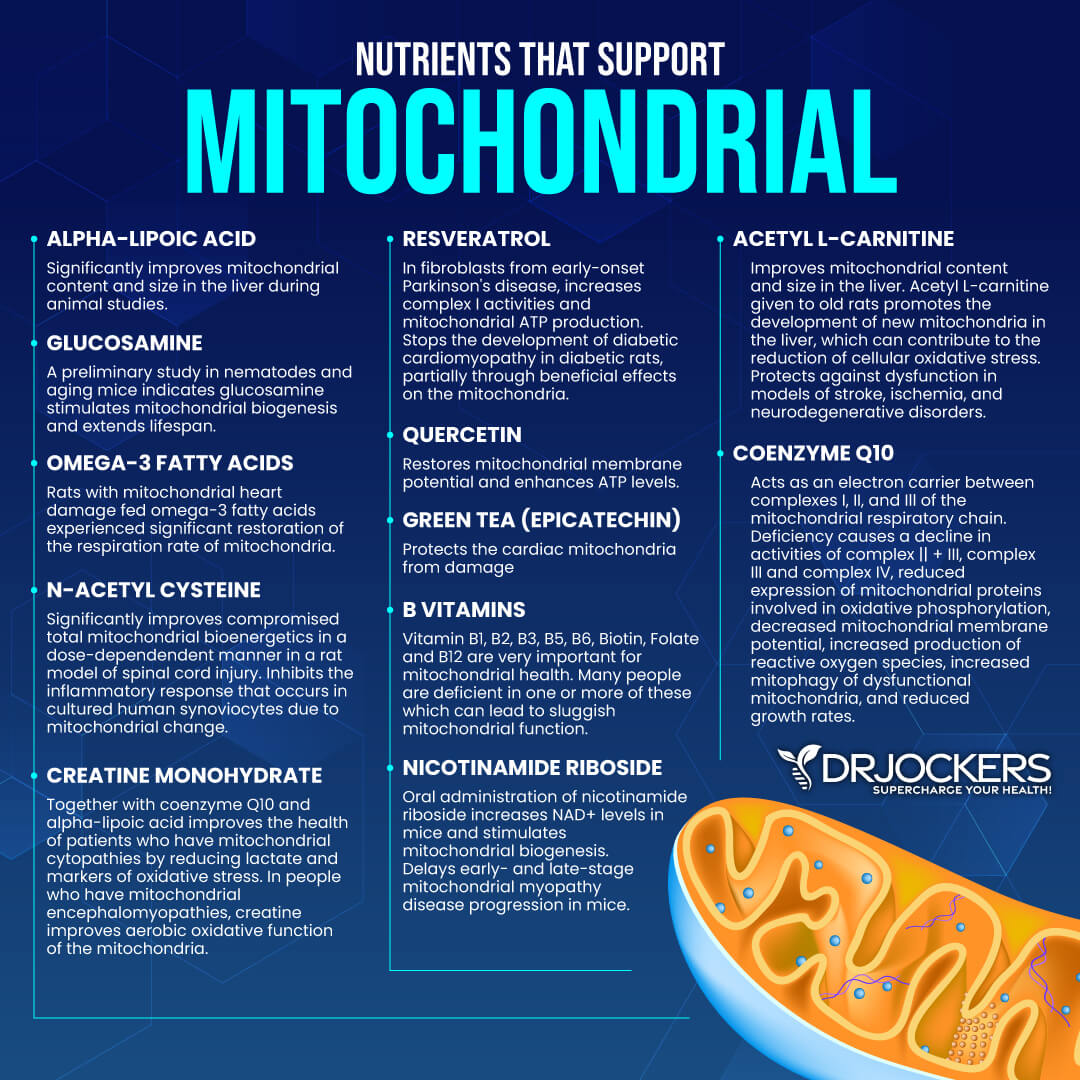
Intermittent Fasting:
Intermittent fasting is a form of fasting cycles between not eating (fasting) and eating (feasting) over a period of time. The benefits of intermittent fasting benefits include cellular repair, autophagy, immune regulation, inflammation levels, and insulin sensitivity.
It also helps to lower the risk of chronic diseases, including neurodegenerative conditions, such as Parkinson’s and dementia. Going 16–18 hours between dinner and breakfast is one of the best ways to improve mitochondrial production. Your body improves energy efficiency by increasing and strengthening the mitochondria during periods of fasting. Consume your meals in a 6-8 hour window such as 11am–7pm or 12–6pm.
When you do this you enhance cellular healing and brain cell regeneration. One molecule that fasting increases is BDNF which enhances the growth and development of brain cells. To learn more about the benefits of intermittent fasting and best intermittent fasting practices, I recommend this article.
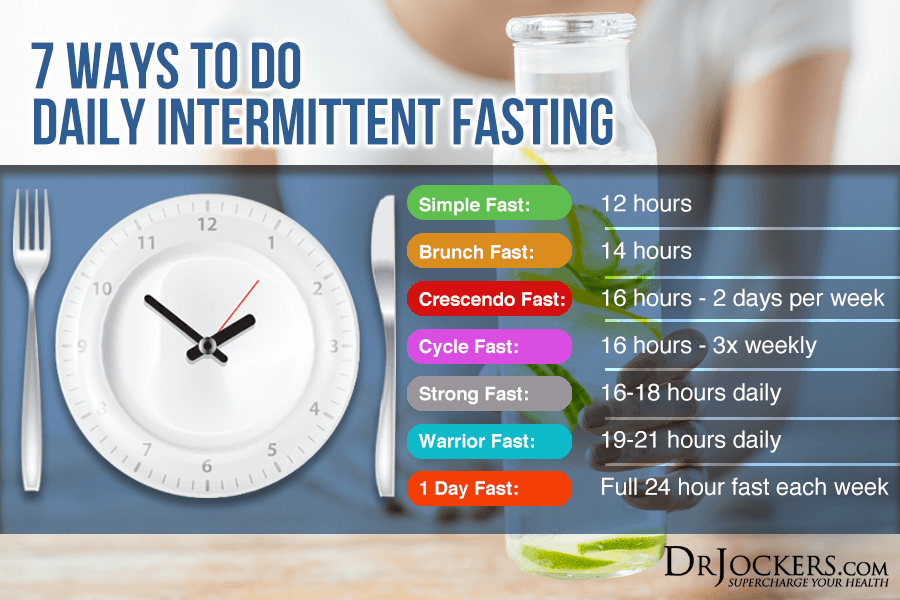
Optimize Your Vitamin D:
Low vitamin D3 is associated with neurological inflammation and neurodegenerative conditions (38). There are vitamin D receptors throughout the central nervous system and critical regions of the brain including the hippocampus.
Researchers have concluded that vitamin D activates and deactivates enzymes in the brain and cerebrospinal fluid that are involved in nerve growth, synaptic density and neurotransmitter synthesis (39).
Vitamin D3 is also shown to boost glutathione production in the neuronal cells protecting them from damage inflicted by oxidative stress. Vitamin D also helps to modulate the immune system to reduce inflammation throughout the body (40).

Support Gut Health
Your brain and gut are closely connected and supporting your gut is important for preventing and reducing brain degeneration. Make sure gut-friendly, anti-inflammatory, and nutrient-dense diet abundant in veggies, healthy fats, clean protein and probiotic-rich foods, such as sauerkraut, kimchi, and kefir.
Additionally, I recommend taking a daily probiotic supplement. Probiotics helps to optimize your gut health and improve your nutrient absorption while reducing gut related inflammation. When gut inflammation goes down it also reduces inflammatory mediators in the brain.

Low Intensity Movement:
A sedentary lifestyle reduces cerebrospinal fluid flow and can lead to increased oxidative stress in the brain. Movement and exercise are critical for brain health and can play an important role in the prevention and treatment of brain degeneration. Regular movement may help to reduce chronic inflammation, decrease stress levels, and lower the risk of memory problems, learning troubles, and cognitive decline.
Aim to exercise at least 20 to 30 minutes minimally 5 times a week combining cardiovascular exercise, strength and resistance training, and low-impact exercise. Make a commitment to stay active throughout the day. Take a walk during lunch, stretch regularly, play with your kids or pets, dance for your favorite song, take the stairs, and find other creative ways to sneak in movement into your day.

Final Thoughts
Alzheimer’s is a serious issue that affects millions of people around the world. The symptoms of Alzheimer’s include memory problems, confusion, disorientation and mood changes. To protect your brain from brain degeneration, follow my tips and natural strategies.
You may notice improvements not only in your cognition, mental sharpness, mood, and energy but also in your overall health. If you want to work with a functional health coach, I recommend this article with tips on how to find a great coach.
Our website offers long-distance functional health coaching programs with our world-class team of health coaches. For further support with your health and other goals, just reach out—our fantastic coaches are here to support your journey.
Inflammation Crushing Ebundle
The Inflammation Crushing Ebundle is designed to help you improve your brain, liver, immune system and discover the healing strategies, foods and recipes to burn fat, reduce inflammation and Thrive in Life!
As a doctor of natural medicine, I have spent the past 20 years studying the best healing strategies and worked with hundreds of coaching clients, helping them overcome chronic health conditions and optimize their overall health.
In our Inflammation Crushing Ebundle, I have put together my very best strategies to reduce inflammation and optimize your healing potential. Take a look at what you will get inside these valuable guides below!







